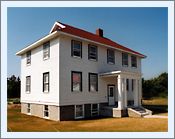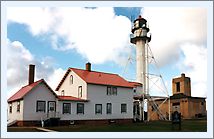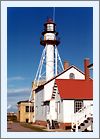|
Historical Information

On the recommendation of
Representative Chipman, the Commerce Committee was instructed to
investigate into the feasibility of erecting a Light at Whitefish Point on
January 13, 1846. After the Commerce Committee provided positive
feedback relative to the importance of establishing the Light, Congress
appropriated the sum of $5,000 for the stationís construction on March
3, 1847. Assistant Land Surveyor James Piper was immediately dispatched
to Whitefish Point to select a site for the new light, and arriving at
the point on April 3, 1847, laid-out 115.5 acres site consisting of cranberry bog and
sand dunes for the station. With the selected reservation officially
recorded in July, work began on laying out the plans and specifications
for the stationís structures.
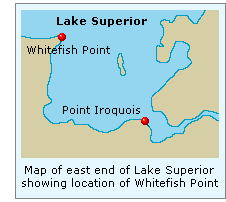 That summer, the irascible Horace Greely sailed into Lake Superior on
his renowned "go west young man" tour of the western frontier.
On seeing first-hand the dangers to maritime commerce represented by
Whitefish Point, and on learning of the fact that the planned lighthouse
had yet to be constructed, Greely penned a scathing article in the New
York Tribune, in which he reported that "On the whole lake there is
not a lighthouse nor any harbor other than such holes in the rock-bound
coast as nature has perforated. Not a dollar has been spent on them.
Congress has ordered a lighthouse to be erected at Whitefish Point and
has provided the means; a Commissioner has located it; every month's
delay is virtual manslaughter; yet the executive pays men to air
uniforms at the Sault in absurd uselessness, and leaves the lighthouse
till another season." That summer, the irascible Horace Greely sailed into Lake Superior on
his renowned "go west young man" tour of the western frontier.
On seeing first-hand the dangers to maritime commerce represented by
Whitefish Point, and on learning of the fact that the planned lighthouse
had yet to be constructed, Greely penned a scathing article in the New
York Tribune, in which he reported that "On the whole lake there is
not a lighthouse nor any harbor other than such holes in the rock-bound
coast as nature has perforated. Not a dollar has been spent on them.
Congress has ordered a lighthouse to be erected at Whitefish Point and
has provided the means; a Commissioner has located it; every month's
delay is virtual manslaughter; yet the executive pays men to air
uniforms at the Sault in absurd uselessness, and leaves the lighthouse
till another season."
Whether Greeleyís article had any influence on the timing of
construction is unrecorded. However, it appears unlikely since the
contract for the stationís construction was not awarded to Sandusky
Ohio contractor Ebenezer Warner until August 21, 1847, and construction
did not begin until the summer of 1848 with the delivery of stone from
Tahquamenon Island by 40-ton Astor-owned schooner FUR TRADER, one of the
earliest large commercial vessels to ply Superiorís waters. Warnerís
crew toiled through the remainder of the navigation season, with the
work finished on November 1.
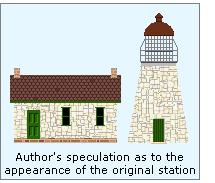 On completion, the new stone tower stood 65 feet tall, with an
outside diameter which tapered from 30 feet at the foundation to 14 feet
below the stone deck. Six windows illuminated the tower interior, and a
yellow pine spiral stairway wound its way up from an entry door on the
ground level to an iron ladder which led the final 8 feet to the scuttle
door in the stone deck. An octagonal iron lantern centered on the stone
deck housed an array of thirteen Lewis
lamps, each equipped with a
14-inch silvered reflector. A simple detached stone dwelling stood 1 Ĺ
stories in height, and contained two rooms on the lower level and a
sleeping area within the attic. At completion, costs of construction at
such a remote location were found to be much higher than expected, with
the total costs for the station coming in at $8,298, which was $3,298
over the original estimate and appropriation. On completion, the new stone tower stood 65 feet tall, with an
outside diameter which tapered from 30 feet at the foundation to 14 feet
below the stone deck. Six windows illuminated the tower interior, and a
yellow pine spiral stairway wound its way up from an entry door on the
ground level to an iron ladder which led the final 8 feet to the scuttle
door in the stone deck. An octagonal iron lantern centered on the stone
deck housed an array of thirteen Lewis
lamps, each equipped with a
14-inch silvered reflector. A simple detached stone dwelling stood 1 Ĺ
stories in height, and contained two rooms on the lower level and a
sleeping area within the attic. At completion, costs of construction at
such a remote location were found to be much higher than expected, with
the total costs for the station coming in at $8,298, which was $3,298
over the original estimate and appropriation.
While James A Starr was appointed as the first Keeper of the
Whitefish Point Light on October 10, 1848, with construction completed
so late in the year, the decision was made to postpone exhibiting the
new light until the opening of the 1849 navigation season. Evidently
Starr must have had second thoughts about serving as Keeper of the
Light, as he resigned his commission on May 2, 1849, to be replaced by
James B Van Rensalaer. During his 1850 inspection of the station in
1850, District Superintendent Henry B. Miller noted that Ransalearís
conduct was good, and recommended that a fence be erected around the
reservation in order to keep "the cattle and Indians away from the
buildings." Regardless of Millerís observations on the Keepersí
performance, Rensalaer resigned his position on May 8, 1851 and was
replaced by Amos Stiles. Evidently living conditions at the remote
station were less than ideal, as a succession of keepers would resign
the position, with seven keepers resigning their positions over the
following decade.
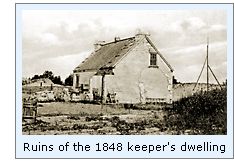 At the dawning of the mid century, the maritime community rose in
anger at the dismally poor administration of the nation's aids to
navigation by the Fifth Auditor of the Treasury. Congress reacted in
1852 by forming the Lighthouse Board, to which it simultaneously
transferred responsibility for the management of all lighthouses. Made
up of individuals with maritime and engineering experience, one of the
Board's first priorities was to undertake a system-wide upgrading of
illumination technology, switching over from the universally adopted
Lewis Lamp to the vastly superior French Fresnel lenses. To this end, a
work crew arrived at Whitefish Point in 1857 to supervise the
replacement of the station's Lewis lamp array fixed white Fourth Order
Fresnel lens, thereby increasing the station's visibility range to 13
miles in clear weather. At the dawning of the mid century, the maritime community rose in
anger at the dismally poor administration of the nation's aids to
navigation by the Fifth Auditor of the Treasury. Congress reacted in
1852 by forming the Lighthouse Board, to which it simultaneously
transferred responsibility for the management of all lighthouses. Made
up of individuals with maritime and engineering experience, one of the
Board's first priorities was to undertake a system-wide upgrading of
illumination technology, switching over from the universally adopted
Lewis Lamp to the vastly superior French Fresnel lenses. To this end, a
work crew arrived at Whitefish Point in 1857 to supervise the
replacement of the station's Lewis lamp array fixed white Fourth Order
Fresnel lens, thereby increasing the station's visibility range to 13
miles in clear weather.
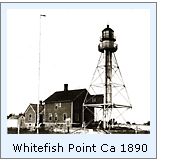 With the opening of the new lock at the Sault in 1855, a major boom
had been experienced in St. Maryís River and Lake Superior maritime
traffic, and a cry arose in the maritime community to improve a number
of the Lights marking critical points along the course. To this end,
Senator Chandler submitted a Bill before Congress on February 10, 1859
requesting that the Commerce Committee be instructed to investigate that
feasibility of improving the lighthouses at Whitefish Point and Manitou
Island in Lake Superior, and at Detour at the Lake Huron entry into the
St. Maryís River. With the opening of the new lock at the Sault in 1855, a major boom
had been experienced in St. Maryís River and Lake Superior maritime
traffic, and a cry arose in the maritime community to improve a number
of the Lights marking critical points along the course. To this end,
Senator Chandler submitted a Bill before Congress on February 10, 1859
requesting that the Commerce Committee be instructed to investigate that
feasibility of improving the lighthouses at Whitefish Point and Manitou
Island in Lake Superior, and at Detour at the Lake Huron entry into the
St. Maryís River.
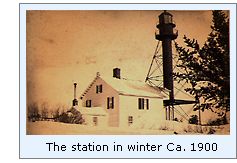 Contracts for the iron work and building materials for the new
station were awarded in 1861, and a work crew dispatched to the island
with the materials that summer. The tower was built of prefabricated
numbered cast iron sections which were assembled in a manner similar to
that of a giant erector set. The tower featured a six-foot diameter
cylindrical cast iron center cylinder of ľ inch plates, with its
interior wall lined with wood paneling to help reduce condensation.
Within this cylinder, a series of 57 cast iron stairs spiraled from the
entry at the lower end to the lantern, which was also fabricated of cast
iron sections. The center cylinder and lantern were supported by four
tubular iron legs which were bolted to concrete foundation pads. The
four legs were in turn supported by horizontal cross members with the
entire assembly provided rigidity by way of diagonal iron braces
equipped with turnbuckles. Interestingly, the central cylinder did not
reach the ground, but was suspended approximately 17 feet above ground
level, with entrance gained from the second floor of the two story wood
frame dwelling through an elevated covered passageway. As witness to the
importance placed upon the station, the tower was capped by a lantern
outfitted with a fixed white Third Order Fresnel
lens. Contracts for the iron work and building materials for the new
station were awarded in 1861, and a work crew dispatched to the island
with the materials that summer. The tower was built of prefabricated
numbered cast iron sections which were assembled in a manner similar to
that of a giant erector set. The tower featured a six-foot diameter
cylindrical cast iron center cylinder of ľ inch plates, with its
interior wall lined with wood paneling to help reduce condensation.
Within this cylinder, a series of 57 cast iron stairs spiraled from the
entry at the lower end to the lantern, which was also fabricated of cast
iron sections. The center cylinder and lantern were supported by four
tubular iron legs which were bolted to concrete foundation pads. The
four legs were in turn supported by horizontal cross members with the
entire assembly provided rigidity by way of diagonal iron braces
equipped with turnbuckles. Interestingly, the central cylinder did not
reach the ground, but was suspended approximately 17 feet above ground
level, with entrance gained from the second floor of the two story wood
frame dwelling through an elevated covered passageway. As witness to the
importance placed upon the station, the tower was capped by a lantern
outfitted with a fixed white Third Order Fresnel
lens.
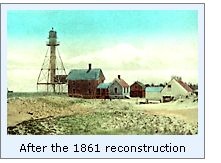 Construction of
the new station continued through the arrival of winter in 1861, and
then resumed with the opening of the navigation. After the entire tower
structure was given a coat of dark brown paint, the new tower was placed
into service late in 1862. While the old tower was demolished
immediately, early photographs the new station show that the old
dwelling was left standing for a number of years. However, we have yet
been able to ascertain into what use it was placed, or when it was
finally demolished.
Construction of
the new station continued through the arrival of winter in 1861, and
then resumed with the opening of the navigation. After the entire tower
structure was given a coat of dark brown paint, the new tower was placed
into service late in 1862. While the old tower was demolished
immediately, early photographs the new station show that the old
dwelling was left standing for a number of years. However, we have yet
been able to ascertain into what use it was placed, or when it was
finally demolished.
During his annual inspections of the station in 1868 and 1869, the
Eleventh District Inspector reported that he found the tower and
illuminating apparatus condition to be "excellent," however,
he also observed that some plastering in the dwelling needed replacing
and that the station could benefit from the installation of a cistern in
the cellar into which runoff from the roof could be diverted as a supply
of drinking water. Also in 1869, it was first mentioned that maritime
commerce in the area would benefit greatly from the addition of a fog
signal at the station. While an appropriation for the establishment of a
number of fog signals throughout Lake Superior had been made, the
Congressional act of July 12, 1870 recalled all unexpended appropriation
balances back to the treasury, and thus no movement had been made on the
establishment of such a signal at Whitefish Point.
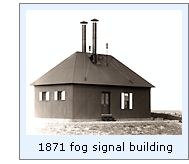 With a new renewed
appropriation in 1871, contracts were awarded for furnishing a
horizontal locomotive boiler and 10-inch steam whistles for the station.
The fog signal building was erected towards the lake from the lighthouse
that year, and took the shape of a twenty-two foot by forty-foot
wood-frame building sided with corrugated iron sheathing. The inner
walls were lined with iron sheathing to reflect the heat generated by
the boilers, and the walls packed with a mixture of sawdust and lime to
provide insulation and to act as a fire retardant.
With a new renewed
appropriation in 1871, contracts were awarded for furnishing a
horizontal locomotive boiler and 10-inch steam whistles for the station.
The fog signal building was erected towards the lake from the lighthouse
that year, and took the shape of a twenty-two foot by forty-foot
wood-frame building sided with corrugated iron sheathing. The inner
walls were lined with iron sheathing to reflect the heat generated by
the boilers, and the walls packed with a mixture of sawdust and lime to
provide insulation and to act as a fire retardant.
The decision was made to change the stationís characteristic from
fixed to flashing in 1892, and flash panels were ordered to effect the
change. Also this year, a contract for furnishing the metal work for a
circular iron oil storage building was awarded, and delivered at the
Detroit lighthouse depot. The following spring, the flash panels and
iron work were loaded on the lighthouse tender AMARANTH, and carried to
Whitefish Point, where a crew erected the oil house and the District
Lampist installed the flash panels and rotating mechanism in the
lantern. In accordance with a previously published Notice To Mariners,
the characteristic of the Whitefish Point lighthouse was changed from
fixed white to fixed white with a red flash every twenty seconds on the
night of June 15, 1893. On May 15 of the following year, the intensity
of the light was increased through the installation of a second order
kerosene lamp within the Third Order lens.
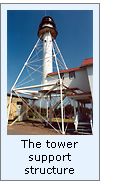 With the increased workload represented by the fog signal station,
plans were underway in 1894 to add a Second Assistant Keeper to the
stationís roster the following year. To accommodate the additional
keeper, a construction crew arrived at the station on the opening of the
1895 navigation season, By June, the crew had modified the original
single family dwelling into a mirrored duplex layout, with separate
entrances and stairways for the Keeper and First Assistant, who lived on
each side. A small frame dwelling for the Second Assistant was also
built to the east of the main building. With the departure of the work
crew at the end of July, the crew had also laid concrete walkways
connecting the station buildings, and repainted the tower white in order
to help it serve as an improved day mark. Later that year, the ball
bearings on which the lens rotated were replaced by a mercury flotation
system. Through this system, the lens floated in a bath of mercury,
virtually eliminating friction. This change allowed the lens to be
rotated at four times the previous speed, and allowed the characteristic
of the Light to be changed on the opening of the 1896 navigation season
to a red flash every 5 seconds. With the increased workload represented by the fog signal station,
plans were underway in 1894 to add a Second Assistant Keeper to the
stationís roster the following year. To accommodate the additional
keeper, a construction crew arrived at the station on the opening of the
1895 navigation season, By June, the crew had modified the original
single family dwelling into a mirrored duplex layout, with separate
entrances and stairways for the Keeper and First Assistant, who lived on
each side. A small frame dwelling for the Second Assistant was also
built to the east of the main building. With the departure of the work
crew at the end of July, the crew had also laid concrete walkways
connecting the station buildings, and repainted the tower white in order
to help it serve as an improved day mark. Later that year, the ball
bearings on which the lens rotated were replaced by a mercury flotation
system. Through this system, the lens floated in a bath of mercury,
virtually eliminating friction. This change allowed the lens to be
rotated at four times the previous speed, and allowed the characteristic
of the Light to be changed on the opening of the 1896 navigation season
to a red flash every 5 seconds.
After 25 years of service, the fog signal building and steam plants
were showing significant signs of wear, and a sub contractor crew
arrived to begin rebuilding fog signal building on July 7, 1896.
Replacement boilers and machinery were delivered by the lighthouse
tender AMARANTH in September, and by October, all pipe connections were
made, the equipment painted pressure tested, and the new signal was
placed into service. Over the following years, a number of additional
improvements were made at the fog signal, with a tramway erected from
the fog signal to the shore in 1900, and the iron smokestacks replaced
by 40-foot tall brick chimneys in 1905. Two years later, 1907 would be
the Whitefish Point fog signalís busiest year, with the keepers
shoveling 43 tons of coal into the hungry boilers to keep the fog
signals screaming for 694 hours.
1912 saw the establishment of an electrically operated submarine bell
2,187 yards from shore in 1912. Designed to take advantage of the high
sound transmission properties of water, the new bell was designed to be
heard through the hulls of approaching vessels to inform them of their
proximity to the station during thick weather. On September 5 of the
following year, the lamp was upgraded to an Aladdin incandescent oil
vapor system with a remarkable increase in intensity from 320,000 to
3,000,000 candlepower. Yet another in a seemingly endless changes in the
lightís characteristic was undertaken in 1918, with the removal of the
red flash panels and a change to occulting white every 2 seconds.
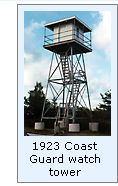 In 1923, the United States Coast Guard erected a life saving station
on the light station reservation. To serve this new crew, a number of
new buildings were erected, including an observation tower from which a
24-hour watch of the waters off the point could be conducted. The steam
power plant and 10-inch whistle were removed from the fog signal
building on August 15, 1925, and replaced with a more powerful
compressed air powered Type F diaphone sounding a group of 2 short
blasts and 1 long blast every minute. With the increased use of radio on
lake vessels, two months later on October 13, a radiobeacon transmitter
was installed in the fog signal building. Transmitting from a tall steel
tower, the transmitter emitted a single dash every 60 seconds during
thick weather, allowing mariners to easily fix their position by
triangulating from other such radiobeacon equipped stations on the lake. In 1923, the United States Coast Guard erected a life saving station
on the light station reservation. To serve this new crew, a number of
new buildings were erected, including an observation tower from which a
24-hour watch of the waters off the point could be conducted. The steam
power plant and 10-inch whistle were removed from the fog signal
building on August 15, 1925, and replaced with a more powerful
compressed air powered Type F diaphone sounding a group of 2 short
blasts and 1 long blast every minute. With the increased use of radio on
lake vessels, two months later on October 13, a radiobeacon transmitter
was installed in the fog signal building. Transmitting from a tall steel
tower, the transmitter emitted a single dash every 60 seconds during
thick weather, allowing mariners to easily fix their position by
triangulating from other such radiobeacon equipped stations on the lake.
In a vicious storm on October 11, 1935, the thirty year old
corrugated iron fog signal building was irreparably destroyed. The
following year a new cream city brick fog signal building was erected
immediately in front of the light tower. As one of the last shore-based
fog signal buildings erected, electricity had been installed at the
station and the building was designed specifically for diaphone and
radio operation, and featured a tall brick tower at the end facing the
lake from which the diaphone resonators protruded, allowing their sound
to carry above the dune and out into the lake.
With constant wave action threatening to erode the shoreline
immediately in front of the station, a number of protective piers were
erected along the shoreline in 1937. After assumption of responsibility
for the nationís aids to navigation in 1939, operation of the
Whitefish Point lighthouse came under the auspices of the Coast Guard.
However the lighthouse and life saving stations crews continued to
operate independently until April 9, 1947, when the two crews were
consolidated, and a six man crew was stationed full time to operate the
light. Fog signal, radio beacon and weather bureau station which had
also been established.
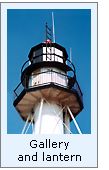 The Fresnel lens was finally removed from the lantern in 1968, and
replaced with a DCB224 aerobeacon, which with its simple and
reliable electronic motor and automatic bulb changer almost eliminated
the maintenance associated with the old Fresnel lens. With advances in
RADAR and LORAN, the old station no longer served its previous
importance, and the station was completely automated in 1971. The
station buildings were placed on the National Register of Historic
Places in 1973, and five years later, the Great Lakes Shipwreck
Historical Society was formed as a non-profit, educational institution,
dedicated to preserving the history and artifacts of the Great Lakes.
With Whitefish Point becoming the focal point for the organization, the
Great Lakes Shipwreck Museum was established in 1985. As part of their
involvement at the Point, the GLSHS has completely restored the keepers
dwelling and coast guard buildings, and most recently has been working
on building an accurate replica of the life saving boat house that used
to sit on the site. The Fresnel lens was finally removed from the lantern in 1968, and
replaced with a DCB224 aerobeacon, which with its simple and
reliable electronic motor and automatic bulb changer almost eliminated
the maintenance associated with the old Fresnel lens. With advances in
RADAR and LORAN, the old station no longer served its previous
importance, and the station was completely automated in 1971. The
station buildings were placed on the National Register of Historic
Places in 1973, and five years later, the Great Lakes Shipwreck
Historical Society was formed as a non-profit, educational institution,
dedicated to preserving the history and artifacts of the Great Lakes.
With Whitefish Point becoming the focal point for the organization, the
Great Lakes Shipwreck Museum was established in 1985. As part of their
involvement at the Point, the GLSHS has completely restored the keepers
dwelling and coast guard buildings, and most recently has been working
on building an accurate replica of the life saving boat house that used
to sit on the site.
Although 1983 saw the replacement of the diaphones in the fog signal
building with an electronic horn mounted on the tower, the Coast Guard
still maintains the lDCB224ís as an active aid to navigation with
maintenance performed by the crew from Coast Guard station Sault Ste
Marie.

Keepers of
this Light

Click here
to see a complete listing of all Whitefish Point Light keepers compiled
by Phyllis L. Tag of Great Lakes Lighthouse Research.

Seeing this Light

We arrived at Whitefish Point after eating lunch in Paradise.
This lighthouse complex is one of the most beautifully restore of all the lights we have visited, and with the addition of the Great Lakes Shipwreck Museum, has become one of the most visited. We toured the lighthouse keeperís residence, which as is the case in many lights, is set up in duplex fashion. All of the oak woodwork and trim has been replaced, and is now likely looks better today than it did when originally built.
After visiting the museum, we went into the theater, located in a secondary residence, and watched a video of the retrieval of the brass bell from the Edmund Fitzgerald, which sank 17 miles Northwest of Whitefish Point November 10, 1975. It was a very moving presentation, and some of the sequences gave a very dramatic view of just how tempestuous Superior can become.
Walking on the beach afterwards, it was very hard to conceive that such a peaceful place can become so incredibly violent.
Finding this Light

Take Wire Road North out of Paradise, and continue approximately eleven
miles to the lighthouse parking area at the end of the road.

Contact information

For information about visiting the Whitefish Point Light Station,
contact:
Whitefish Point - Great Lakes Shipwreck Museum
400 W Portage Ave
Sault Ste. Marie, MI 49783
(906) 635-1742

Reference
Sources

Congressional records,
various, 1846 - 1872
Annual report of the Fifth Auditor of the Treasury, 1850
Annual reports of the Lighthouse Board, 1853 - 1909
Annual reports of the Commissioner of Lighthouses, 1910 - 1939
History of Whitefish Point, Janice H Gerred, Inland Seas, 1984
Whitefish Point Lighthouse, unpublished chronology, Donald L
Nelson
Great Lakes Light Lists, various, 1861 - 1972
Draft Management Plan for Whitefish Point, Michigan Land Use Institute,
2002
Foghorns Saved Lives, Too, Vivian DeRusha Quantz, 1999
Lake Superior's Shipwreck Coast, Frederick Stonehouse. 1985
Photographs from author's personal collection.
Keeper listings for this light appear courtesy of Great
Lakes Lighthouse Research
|
